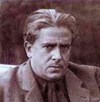
|
Francis Picabia was born in Paris, but was of Spanish descent. His father was a wealthy Cuban, who was attache to the Cuban legation in Paris.
At 16 Picabia began to paint and visited the École des Beaux-Arts.
In 1905 he had his first personal exhibition.
From 1910 the French painter, poet and writer Picabia came in the forefront of the avant-garde. Through his friendship with the brothers Duchamp: Gaston, Raymond and Marcel, he came into contact with cubism, followed by Dadaism and surrealism.
His (almost) abstract painting in the period 1912-1914 made impression, especially in New York, and thanks to the notorious Armory Show in 1913 he was named in one breath with Matisse and Duchamp. He was then considered as one of the Cubists.
At the beginning of WWI Picabia came to the United States. In New York he met his friend Marcel Duchamp and they founded in l915 a “Dada” Group.
After a stay in Switzerland in 1918 Picabia became the driving force behind the Paris Dada Movement, which was grown in 1920 around the writer Andre Breton. Later he organized Dada-Events where also Marcel Duchamp participated in. It is in this period that Duchamp presented his Mona Lisa with the mustache and Picabia his toy monkey with the title 'Portrait of Cezanne'

